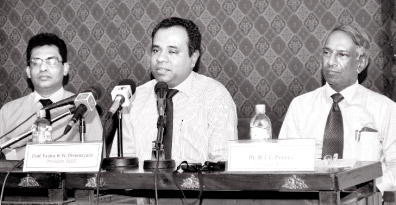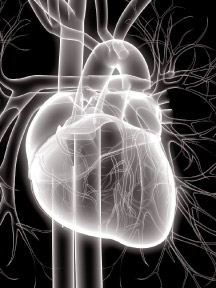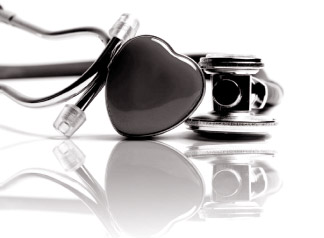|
Health Watch
The Sri Lankan Personal Health Record (PHR) system:
Medical record keeping, no longer an issue!
Ishara JAYAWARDANE
There is a saying that ‘Truth is stranger than fiction.’ Remember the
time we used to watch Star Trek and Star Wars and all those crazy films?
Now envision a world where every thing is carried on our mobile phone.
Imagine that tiny device holding every detail of our personal lives.
Yes, it is possible and it will happen very soon in the future.
|

Dr. Deepal Wijesooriya, Inventor of the
Sri Lankan Personal Health Record
System |
Just think of the convenience. Information is fast reaching a new
stage of mobility. Daily News recently walked into the future at a Press
Conference held by the Sri Lanka Medical Association. While I was
sitting there I could appreciate how audiences felt when watching
Jurassic Park.
The Personal Health Record System is now in Sri Lanka. This is all
due to Dr. Deepal Wijesooriya’ s pioneering efforts. The Inventor of the
Sri Lankan Personal Health Record System, Wijesooriya has studied this
system in other countries and now has created it in a way that is
applicable to Sri Lanka and the needs of Sri Lankans.
“This press conference has been convened to increase awareness on
this novel programme. It is the Personal Health Records System.
Information in the form of hard copies is being replaced by this new
programme.
This is a quantum leap in Sri Lanka. The future of medicine may even
be in your cell phone,” said President of Sri Lanka Medical Association,
Dr. B.J.C Perera.
Easy access
Now more than ever before the connection between computer science and
medicine has gone to a higher level. Information technology is playing a
pivotal role in modern day medicine and its treatment. No longer are
sheets and sheets of medical information bundled up in a bag. One click
of the button and the information is on the computer screen.
|

(Left to Right)- Dr. Deepal Wijesooriya, Inventor of the Sri
Lankan Personal Health Record System, Professor Vajira. H.W.
Dissanayake, President Health Informatics Society of Sri
Lanka, Dr. B.J.C. Perera, President of Sri Lanka Medical
Association. Pictures by Sarath Peiris |
It can be accessed anywhere in the world. If you are a Sri Lankan
visiting India, you can easily access the information in India via
website. You don't have to physically carry the information with you
when traveling. “Medical information is stored on the web, a print out
is taken and shown to the doctor. Information stored as hard copies in
hospitals are difficult to retrieve,” said President Health Informatics
Society of Sri Lanka, Professor Vajira. H.W.Dissanayake,
Sometimes when asked questions related to the patients treatment
history, the patient may not know how to answer. So with the limited
time the doctor has, he/she may be unable to make a correct diagnosis. “
Sometimes the patient has to go to multiple doctors and when asked
questions related to treatment the patient does not know how to answer
which makes treatment difficult. The usage of Electronic Medical Records
is going through a rapid transformation,” said Inventor of the Sri
Lankan Personal Health Record System Dr. Deepal Wijesooriya.
There are two types of patients: Patients with Medical Records and
Patients without Medical Records. In the case of Patients with Medical
Records - consultative time is productive. In the case of Patients
without Medical Records - Consultative time is less productive. Patients
with Medical Records facilitates less errors and active participation.
Patients without Medical Records registers more errors and passive
participation.
The Personal Health Record is initiated and maintained by an
individual of his own health. “PHR version 1.0” is an electronic web
based system which is tailor made to Sri Lankan Health Needs. Any Sri
Lankan who has an email address and internet accessibility, can use this
system to keep their health records online. This system has capability
to share information with other systems like Electronic Medical Record (EMR),
Hospital Information System (HIS) and laboratory systems. Profile owner
can keep his /her health related events and medical records in a secure
place due to PHR version 1.0. Because this system is password protected
and can only be accessed by authenticated individuals decided by him.
Sudden cardiac death in young adults
Dr. Yanushi Dullewe Wijeyeratne BMBS(UK), BMed Sci
Hons (UK)
Atleast 12 young people die suddenly each week in the UK of
undiagnosed cardiac conditions. Instances of young Sri Lankans dying
suddenly with no apparent cause are heard frequently, but the exact
incidence is unknown. Diagnosis of the cause of unexplained sudden death
is often difficult, even after post mortem. The majority of these deaths
could have been prevented. Many victims may have had symptoms that had
not been recognised.

Acquired causes of sudden death can vary vastly, and drug-induced
causes should always be excluded through a thorough toxicology screen.
It is vitally important for the bereaved family to know the cause of
death to help in their grieving process. There can be many unanswered
questions after a young person dies suddenly. The post mortem
examination may not always provide the answers.
Was it really a ‘heart attack’?
Incidental findings at post mortem may sometimes be mislabelled as
the cause of death. For example, a myocardial infarction, or ‘heart
attack’can only be attributed to the cause of death in someone who has
previously been fit and well if there is definite evidence of complete
occlusion of a coronary arteryat post mortem, or if the characteristic
changes in heart muscle that indicate that a heart attack has occurred
are seen when the pathologist examines the deceased heart.
Many people have a degree of plaque build up in the coronary blood
vessels with age, but this plaque build up will not cause a heart attack
or sudden death unless the plaque has ruptured or caused obstruction of
that blood vessel. However, there have been many instances even in the
UK when the cause of death has been mislabelled as myocardialinfarction
(heart attack) in people who have died suddenly. On subsequent
examination of the deceased heart by a specialist cardiacpathologist, it
is found that the cause of death is entirely different and not related
to coronary artery disease.
Diseases of the heart muscle, the most common of which is
hypertrophiccardiomyopathy (HCM), account for most cases of sudden
cardiac death in young adults under the age of 35 years. Beyond 30-40
years of age,coronary artery disease rapidly increases in frequency and
overtakes hypertrophic cardiomyopathy as the commonest cause of sudden
cardiacdeath in adults with advancing age.
Apart from diseases of the heart, other causes of sudden death that
need to be considered when a person dies suddenly include seizures or
fits that may have led to prolonged loss of consciousness and death
(known as sudden death in epilepsy).

Sometimes no definitive cause of death is found on postmortem and the
heart is entirely structurally normal, in which case the death may have
been due to a rhythm abnormality or electrical problem in the heart.
Certain inherited conditions known as cardiac ion channelopathies
predispose the heart to fatal rhythm disturbances leading to cardiac
arrest. Examples of these conditions include Brugada syndrome, the
inherited Long QTsyndromes and the Wolff-Parkinson-White (WPW) syndrome.
These conditions are very rare and may often be undiagnosed, but they
can still account for a notable number of sudden cardiac deaths in young
people.
Brugada syndrome most commonly affects young South EastAsian males,
although cases of Brugada syndrome in Sri Lankans have been reported. It
typically causes death during sleep in affected individuals
intheir30s-40s. Natural slowing of heart rate during sleep may be a
contributory factor. Wolff-Parkinson-White syndrome also pre disposes
the heart to fatal rhythm disturbances, but via a different mechanism
that involves an extra abnormal electrical pathway in the heart.
Inherited long QT (LQT) syndromes are the most common and
best-understood ion channel disease of the heart pre disposing to sudden
death.‘LongQT’ refers to the pattern on an affected person’s ECG. One
type of inherited long QT syndrome typically causes death on exposure to
cold water and exercise. It should be suspected when a young person dies
whilst swimming for example, or if a young person blacks out or loses
consciousness during swimming. If diagnosed, drug therapy can be very
effective in preventing sudden death in this type of long QT syndrome.
Another type has been associated with death following exposure to
intense emotion or sudden loud noises, for example Long QT syndrome type
2may be suspected if a person drops dead suddenly after having been
woken up by a loud alarm clock. It should also be suspected when a young
person collapses or dies suddenly immediately after receiving unexpected
bad news, or whilst being very excited or laughing.
In Long QT3, which is similar in aetiology to Brugadasyndrome, the
slow heart rate whilst sleep can trigger fatal arrhythmias and lead to
sudden death during their sleep.
Heart muscle disorders / Cardiomyopathies
Cardiomyopathies refer to structural diseases of the hear muscle,
which may or may not be inherited. Hypertrophic cardiomyopathy is an
inherited condition causing focal thickening and scarring of the cardiac
muscle, which in severe circumstances causes obstruction of blood flow
out of the heart. It affects about 1 in 500 people and can affect both
males and females of any ethnic background. Symptoms can begin at any
age, but may not appear until mid-life (30s-40s). It is the most common
cause of sudden cardiac death under 35 years of age, especially in
athletes.
In the United States, up to one third of sudden deaths during
exercise in young competitive athletes have been shown to be due to
HCM.Other cardiac conditions that can lead to sudden cardiac death
during exercise include coronary artery anomalies, and arrhythmogenic
right ventricular cardiomyopathy (ARVC).
People with a cardiomyopathy or cardiac muscle disorder may not have
any symptoms at all, and in some circumstances, the first symptom maybe
sudden collapse and death during exercise, for example during
competitive sport or marathon running. For this reason, many
international sportsorganisations do not allow athletes to compete
unless they have been screened for these conditions.
Symptoms to look out for, if present, include feeling faint,dizzy or
even blacking out during physical activity, excessive shortness ofbreath
disproportional to the degree of physical effort, exertional chest
discomfort or palpitations on exertion. Anyone who has experienced these
symptoms should seek medical advice and be screened for a potential
underlying cardiac condition that could put them at risk of sudden
cardiac death.
Management of the risk of sudden death
If diagnosed, drug therapy can modify disease progressionand lower
the risk of sudden death in some cardiomyopathies and in certain types
of LQT syndromes, and cardiac ablation procedures can destroy the extra
electrical pathway in WPW syndrome. However there is currently noproven
treatment for Brugada syndrome apart from lifestyle measures that can
lower the risk. The only way of definitively preventing premature sudden
death in Brugada syndrome is by implanting an implantable cardioverter-defibrillator
(ICD).
ICD s are also indicated in anyone who has already had acardiac
arrest and been successfully resuscitated, and in anyone with
anyinherited cardiac condition at high risk of sudden cardiac death
despiteappropriate risk modification. An ICD is a pacemaker-like device
that isimplanted under the skin, and can deliver a shock if the heart
does go into alife-threatening rhythm, thereby restoring the heart’s
normal rhythm. ICDs arehowever not without risks, including lead
displacement, infection and damage tothe heart during implantation,not
forgetting the impact on a young person ofhaving a life long medical
device. Therefore the decision to implant an ICD should never be taken
lightly.
Minimising the risk of sudden cardiac death in sport
The increased stress on the heart during intensive physical exercise
and regular high intensity training can trigger a sudden death by
aggravating an undetected cardiac abnormality. It must be stressed that
sportand regular physical activity is healthy on the heart and must be
encouraged, however in a minority of individuals who have certain
inherited structural or electrical abnormalities of the heart, sport can
trigger fatal arrhythmias and death.
This is why education and screening of any young person who engages
in regular high intensity exercise is crucial to rule out any potential
undiagnosed underlying heart condition. Although some affected people
may have had symptoms like blackouts, dizziness, palpitations, chest
pains or disproportionate shortness of breath on exertion, many
individuals dying suddenly had not experienced any symptoms, and cardiac
screening to look for these conditions predisposing to sudden cardiac
death is the only way that could have potentially saved their lives.
The International Olympic Committee (IOC) and the European Society of
Cardiology recommend cardiac screening for any young person taking part
in competitive sport. This may include schoolchildren over the age of
14years who take part in national or international competitive sport.
The reason that screening is not encouraged in younger children is
because the results canbe inconclusive before adolescence. In some
countries such as Italy, screening is mandatory before any competitive
sports. If a condition that puts the person at risk of sudden cardiac
death during exercise is diagnosed, participation in competitive sport
is restricted, amongst other preventative measures to minimise their
risk.
Improving awareness and family screening
International clinical guidelines strongly recommend screening for
potential inherited cardiac conditions in any first degree relative
whose family member has been diagnosed of an inherited heart condition
such as one described above, or if they have had a family member that
died suddenly of an unexplained cause. This also includes relatives of
family members who have had motoring accidents, if there is a
possibility that the accident may have been caused by the family member
having a blackout whilst driving.
A simple ECG following history and physical examination by a
clinician experienced in this subject area can effectively screen for
inherited cardiomyopathies or conditions predisposing to heart rhythm
disorders, even in asymptomatic individuals. This may be followed by an
echocardiogram (ultrasoundscan of the heart) for further information.
For some individuals however, further diagnostic tests and imaging are
needed to reliably rule out a potential lethal cardiac condition.
A final point of caution is that, in athletic individuals, there can
be a lot of overlap between normal, healthy athletic adaptation of the
heart with exercise, and pathological changes on the ECG and echo. Hence
interpretation of any screening tests by a cardiologist or a physician
experienced in interpreting such tests is essential before making any
diagnosis which can potentially have a major impact on an individual’s
lifestyle.
[email protected]
(The writeris a medical doctor at St George's Hospital in London
and has authored severalarticles published in international scientific
journals)
Daily News Medical Crossword No: 56
Across
1.World AIDS Day, is observed in this month, every year.(8)
8.A medical condition which is associated with obesity.(12)
10.Fill in the blank. Naltrexone Hydrochloride is used to help with
patients with ------(7) dependence.
11.Obesity is associated with cancer in this organ.(5)
15.As the health field makes significant advances every day, this
aspect has become an integral part of nursing in recent years.(8)
16. An epidemic occurring worldwide or over a very wide area,
crossing international boundaries, and usually affecting a large number
of people.(8)
Down
1.Deoxyribonucleic acid.(3)
2.Optical Coherence Tomography (OCT) is a scan that measures the
thickness, of this part of the eye.(6)
3. Multiple sclerosis is an illness that can affect this organ of the
body.(5)
4. This is one of the top ten caring behaviours.(8)
5. A hormone produced by the beta cells of the pancreas that permits
glucose to enter cells and helps the body use glucose for energy.(7)
6. A condition in the liver, which is associated with excessive use
of alcohol.(9)
7. Cardiopulmonary resuscitation.(3)
9. Clouding of the lens inside the eye which leads to a decrease in
vision.(8)
12. The profession or practice of providing care for the sick and
infirm.(7)
13. Fill in the blank. The cessation of normal circulation of the
blood due to failure of the heart to contract effectively is known as
cardiac ------- (6)
14. The protective sheath or layer around nerves.(6)
Crossword created by Dr. Kelum Pelpola, Coordinated by Edward
Arambewala Send your entries to reach us by April 1, 2013 to:
Daily News Medical Crossword No: 56, Healthwatch, C/O Features
Editor, Daily News- Editorial, No.35, D.R.Wijewardena Mawatha, Colombo |







